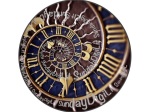This is one of a series of blog posts that continue the conversation around Still Learning to Read--teaching reading to students in grades 3-6. This series will run on the blog on Tuesdays starting in August 2016.
Read Aloud is one of my most important teaching times. It is comfortable and joyful with great stories and great talk. My role is to find books that invite conversations that I know will help my students grow as readers. My plan before school started was to begin our read aloud with 4-5 short chapter books and then to move to something longer. But after reading Lulu and the Brontosaurus and Mercy Watson to the Rescue, I decided this group needed a bit more to talk about in order for them to learn to talk deeply around books. So I changed my plans a bit and moved to a longer, more complex series book. Last week we started Dog Days (a book in The Carver Chronicles Series) by Karen English.
Why I Chose This Book:
I chose this as our next read aloud for several reasons. I thought the kids were ready for a book with more to talk about. Many are in the transitional stage of reading and they struggle a bit with keeping track of a story, keeping track of characters and sticking with books. This book is probably beyond what many of my kids could read on their own but the teaching focus I have for this book will support readers at a variety of levels. The book will invite conversations about characters and characters who change across the book. I also liked that this book had lots of good features like a Table of Contents, a back blurb that sets up the story, etc. that will help us begin conversations about previewing books before you read.
Setting Up the Preview:
I am a strong believer that transitional readers must learn to "introduce themselves" to a book. I think to be able to chose the right books, a preview is critical. As a reader, I need to know lots about a book before I decide it's the book I want to read next. But previewing is about more than choosing books. Previewing a book sets the reader up for more engagement. Kids are always amazed at how much you can learn BEFORE you even start the book if you take the time to preview a bit. So, on the day we were to begin Dog Days, I had this chart ready in our read aloud area. I set it out before the school day began knowing a few curious kids would give it a look and start thinking about and wondering what it was.
Then during our read aloud time last Thursday, we previewed the book. We have a 25 minute read aloud time each day and the whole class preview took the entire read aloud time on Thursday. Tougher we looked at the cover, read the back cover, read the table of contents and read the first page of the first chapter. After each feature, we stopped to talk about the things we knew, the things we predicted and most importantly the questions we had. The kids were amazed (as they usually are the first time we do this) that they had so much thinking before we even started the book! I have learned that kids won't instantly begin previewing the books they read independently after a few read aloud previews but my goal is for them to eventually see the power of a preview in their reading.
We actually began reading the book on Friday and before we started a student mentioned that he'd been thinking about the book. Several kids agreed. Such a great way to start a read aloud with kids thinking about the book between readings. Throughout the first day's reading, we referred back to things we had read in the preview--thinking that was confirmed, thinking that we changed with new information and questions that were answered. Every time we went back to a feature we had previewed, we found the exact line that we were thinking about which always raises the level of talk. I can tell this is going to be a great read aloud! I am anxious to see where the talk goes.
(You can follow the conversation using the hashtag #SLTRead or you can join us for a book chat on Facebook that began this week by joining our group here.)
Our new edition of Still Learning to Read was released last week! You can order it online at Stenhouse!

















